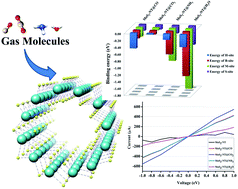Environmentally hazardous gas sensing ability of MoS2-nanotubes: an insight from the electronic structure and transport properties†
Abstract
Herein we have investigated the ability of the (6,6) MoS2-nanotube (NT) to sense environmentally hazardous electrophilic and nucleophilic gases using density functional theory (DFT). CO, CO2, H2O and NH3 gases were chosen for adsorption on the (6,6) MoS2-NT and different adsorption parameters such as adsorption energy, projected density of states (PDOS), band structure and structural changes after adsorption were evaluated. Nucleophilic gases NH3 and H2O showed a fairly high amount of electron density transfer from gas molecules to the NT while the opposite trend was realized for electrophilic gases CO and CO2. Among the four gases, H2O has the highest amount of adsorption energy (−1.74 eV) and a moderately high amount of charge transfer from H2O to the NT. Gas sensing behaviour was further rationalized from the enhanced I–V characteristics of gas adsorbed nanotubes compared to pristine ones. Analysis of results revealed that the (6,6) MoS2-NT showed a decent level of gas sensing properties towards CO, CO2, H2O and NH3 gases, and high selectivity for H2O makes the MoS2-NT superior to previously reported MoS2-monolayer in this matter. These results suggest the possibility of fabrication of highly efficient MoS2-NT based gas sensors for environmentally hazardous gases.



 Please wait while we load your content...
Please wait while we load your content...